%$77(5,(6
&RS\ULJKW7UDFH(QJLQHHULQJ&R,QF 7HOHSKRQH 3DUW1XPEHU
WK
6WUHHW1( )D[ 2FWREHU
$UOLQJWRQ:$86$ ZZZWUDFHHQJLQHHULQJFRP 3DJH
accurate information compared to the motor nameplate. If large motors will be started, increase the
battery size to allow for the high demand start-ups require.
Battery Bank Sizing Example & Worksheet
Complete the steps that follow to calculate your battery bank capacity. No two installations will
require exactly the same battery bank capacity. The example that follows will provide a guideline for
determining your needs. Read through the example and then complete the worksheet on the
following page.
Step 1: Multiply the number of hours (or fractions of hours) you will use the appliance each day by
the wattage of each appliance. Total these
Daily Watt-Hours
to determine your
Daily Energy
Required
;
Step 2: Multiply the
Daily Energy Required
by the number of anticipated days of autonomy (days
between charging, usually one to five) to determine your
Rough Battery Estimate
(example used
three);
AC Appliance
Hours of
Daily Usage
Appliance
Watts
Daily Watt-Hours Used
Microwave 0.5 600 300
Lights (x4) 6 40 240
Hair Dryer 0.75 750 563
Television 4 100 400
Washer/Dryer 1 375 375
STEP 1
Usage X Watt Hours = Total Watts 1878
STEP 2
Days of Autonomy X Total Watts 5634
STEP 3
Safe Battery Size (watt-hours) 13522
STEP 4
Amp-Hours Required 1127
INVERTER
Minimum Inverter Size Required 2000
Step 3: Multiply your
Rough Battery Estimate
(Step 2) by two. This allows for a maximum 50%
normal battery discharge and an additional 50% for emergency situations. Multiply this figure by 1.2
to allow for an efficiency of 80%. This number is your
Safe Battery Size
in watt-hours.
Step 4: Convert Safe Battery Size in watt-hours to amp-hours. The formula is Safe Battery Size
(Step 3) divided by DC system voltage (example used 12-volts). This is the Amp-Hours Required
each day from your battery bank without recharging.
Inverter: This is the minimum inverter size required. Add together the appliances that will run at the
same time from Column 3 (Appliance Watts, listed above). You will need an inverter with this many
watts or more.

